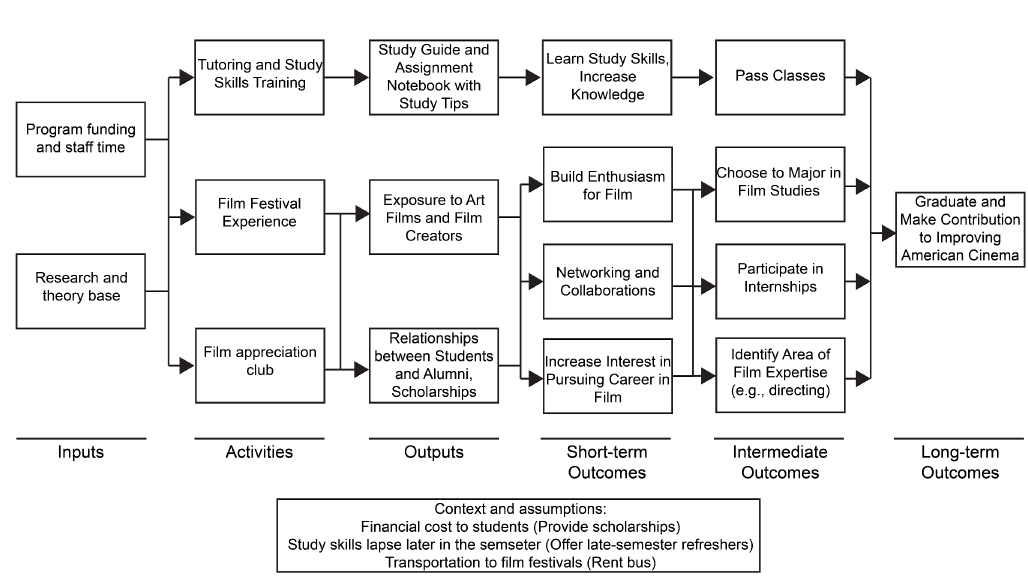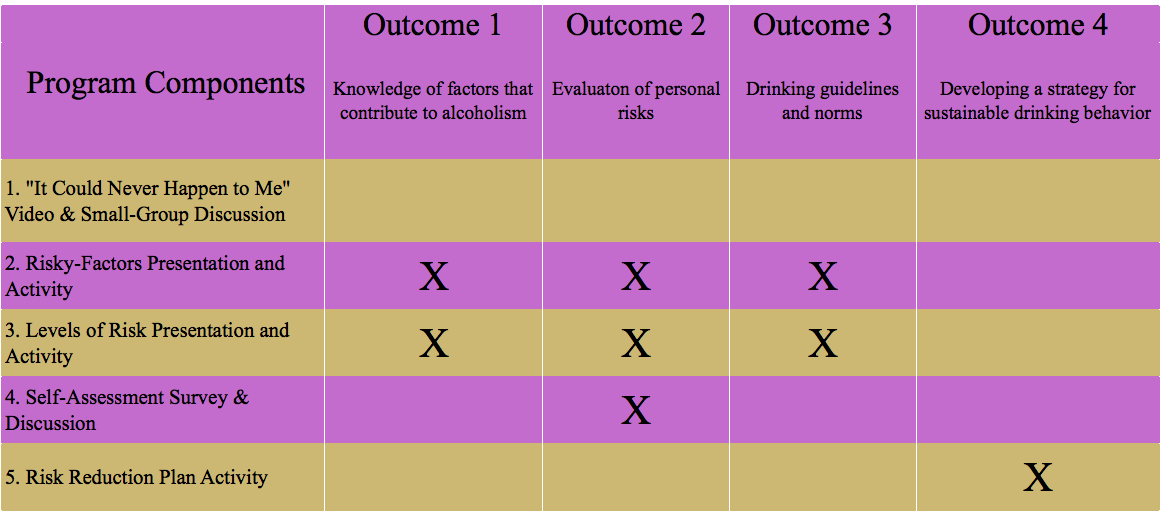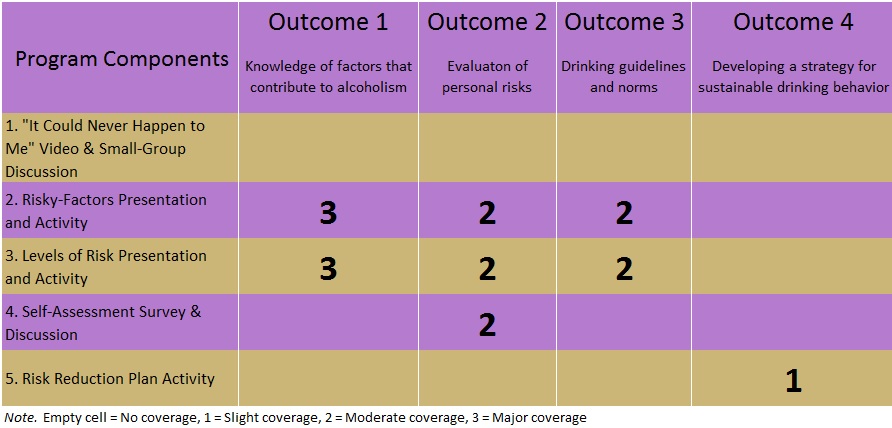The second step in the Assessment Cycle is programming with purpose. Now that you have specified your student learning and development outcomes (SLOs), you need to 1) determine how to achieve those outcomes (i.e., develop a program theory) and 2) clearly articulate the connection between program components and SLOs (i.e., develop a logic model and/or program-to-outcome map). During this step of the process, you will need to consider questions such as:
- Which components of your program are hypothesized to lead to which SLOs?
- Why do you believe these program components should lead to the stated SLOs?
- What do relevant theories say about how to impact your SLOs?
- What evidence-based practices have been shown to impact your SLOs?

What is Program Theory?
Program theory or logic explains how and why a program is expected to work. It makes explicit the connection between the things we do in our programs and the outcomes we hope to achieve. Ideally, this logic should be evidence-based. That is, we should seek to consult theory and empirical research when developing a program theory.
The Council for the Advancement of Standards in Higher Education (CAS) recognizes the importance of program theory.(CAS) recognizes the importance of program theory. According to their standards, programs should be 1) intentionally designed and 2) guided by theories and knowledge of learning and development.
How to Build a Theory-Based Program
A theory-based program is one that is intentionally designed to address a certain problem or achieve a certain goal. Theory-based programs can be contrasted with less intentional programs that are often conceived with little thought as to 1) what changes are desired in students' knowledge, attitudes, skills, and behaviors, and 2) how such changes can be reasonably facilitated (i.e., program theory).
Developing a Theory-Based Program in Five Steps
Program Theory in Ac
Step 1: Articulate the Problem
Building a theory-based program begins by clearly articulating the problem you are trying to address or the goal you are trying to achieve. These problems/goals should be meaningful to stakeholders.
Step 2: Identify Plausible Causes and Solutions
Once you have a clear problem or goal in mind, the next step is to consult relevant theory and empirical research to learn more about the underlying causes of the problem and theory-based solutions/strategies given those underlying causes.
Step 3: Select a Course of Action
There is likely more than one theory that has garnered empirical support, which is advantageous as it indicates more than one approach to designing a program to meet the intended SLO. Thus, the next step is to select a reasonable course of action given what you know about your specific institutional context (e.g., the unique needs of your students, resource constraints, institutional priorities, etc.).
Step 4: Develop an Intentional Program
Once you have decided on a course of action (i.e., what you're going to do), the next step is to figure out how to do it. In other words, while theory may provide an outline for your program, it is up to you to fill in the details. A good starting point is to look for intervention studies, or empirical research articles where practitioners describe a particular theory-based intervention and evaluate its effectiveness. It may also be helpful to consult the literature on how students learn (learning theory) and/or how attitudes and behaviors are changed (persuasion theory). Additionally, there is extensive literature on evidence-based pedagogical techniques that can be particularly useful for educational or co-curricular programs.
Step 5: Evaluate Program Effectiveness
Once you've built and implemented a theory-based program, the next step is to evaluate its effectiveness. If you find that your program is ineffective, it may be an indication that 1) the theory/research you pulled from in Step 2 is wrong or does not generalize to your population of students, 2) the course of action you selected in Step 3 is inappropriate given your specific context, or 3) the particular methods you employed in Step 4 were ineffective or insufficient. Once you've identified where the breakdown occurred, the final step is to make intentional, theory-based changes to the program based on this information.
Click here to see each of these steps applied to a hypothetical program targeting binge drinking behavior.
1American College Personnel Association & National Association of Student Personnel Administrators (2015). ACPA/NASPA professional competency areas for student affairs educators.Washington, DC: Authors.
Developing a Logic Model
A logic model is a depiction of the relationships between program components and outcomes. In other words, a logic model shows which program components will lead to which outcomes, and most importantly, how (i.e., through what causal mechanisms) this change will occur. In this way, logic models can be conceived of as illustrations of the program theory underlying a program. As such, the arrows in these models should be evidence-based.
A Realistic Example
The logic model below was created by Jeremy Penn in the Office of Teaching and Learning at North Dakota State University.
Click image to enlarge
Creating a Program-to-Outcome Map
The primary purpose of a program-to-outcome map is to ensure that each SLO is sufficiently addressed by your programming. In other words, does your program provide students with an opportunity to achieve all of the stated outcomes?
Additionally, program-to-outcome maps help with use of assessment results. If you find, for example, that students did not achieve a certain SLO, you can use a program-to-outcome map to figure out what components of the program need to be reevaluated.
Example 1: Simple Coverage Map
In this map, an "X" indicates which program components contribute to the achievement of which outcomes.

Check For Unnecessary Program Components
- Note that the first program component (video and small group discussion) does not map to any of the program's outcomes. This should prompt facilitators to reevaluate this activity. Is it necessary? Does it detract from other more important activities? Although there are some instances where it may be appropriate to include an activity that does not map to a specific outcome (e.g., some introduction or "ice-breaker" activities), there should be a compelling reason to do so.
Example 2: Degree of Coverage Map
This map is more detailed; it not only specifies which program components map to which outcomes, but the degree of coverage that each program component provides.

Check For Unaddressed Outcomes
- Note that Outcome 4 has minimal coverage. Only one component (i.e., the "Risk Reduction Plan" activity) is mapped to it, and the coverage of this activity is slight. This should prompt facilitators to question whether the program adequately equips students to achieve Outcome 4. Is additional programming necessary? Or should existing programming be strengthened?
Integrating AI
Program Theory
As you refine your program theory, AI tools can help with brainstorming, clarifying connections, and organizing ideas; but remember that expert judgment is essential.
What do relevant theories say about how to achieve your SLOs?
For new programs:
Copilot Chat and ChatGPT can assist in:
- Refining preliminary descriptions of your program theory based on your SLOs and supporting theories.
!!! Note: Copilot Chat and ChatGPT should not be used to search for existing theories, they can provide false citations or incorrect information. They may be used to assist your work but should not replace expert judgement. !!!
Scopus AI can:
- Create a summary of theories that tie your programming to your outcomes with real citations and an associated reference list.
- Curate a narrow list of empirical articles that are relevant to your programming and outcomes.
- Build a concept map that ties concepts together in your field of study.
!!! Note: Avoid relying on the summary from Scopus AI as the sole text for your program theory. This summary should be used as a starting point to help you understand some of the different theories that support your programming and outcomes. You should conduct your own literature review to ensure all relevant literature has been consulted. !!!
For inherited programs:
If you’re working with an existing program theory, you can…
- Upload the theory to Copilot Chat or ChatGPT to check for clarity and logical flow.
- Ask AI tools to help identify missing links or unclear connections between components and outcomes.
Program Mapping
What programming would you implement to foster desired learning and development?
For new programs Copilot Chat and ChatGPT can assist in:
- Suggesting activities that align with your desired learning and development outcomes.
- Helping structure and build out your program components.
Why should this programming impact the intended outcomes?
For new programs:
AI can provide basic rationale for how your proposed activities align with your outcomes. Copilot Chat and ChatGPT can assist in…
- Clarifying why specific activities contribute to student learning.
- Ensuring your programming has a clear purpose tied to your SLOs.
!!! Note: AI will find a connection even if the connection is not strong or relevant for your specific programming. It may be used to assist your work but should not replace expert judgement. !!!
For inherited programs:
You may be given a program that already has program theory, components, and outcomes drafted. Tools like Copilot Chat and ChatGPT can help identify connections between program components and outcomes when you…
- Upload the relevant program theory, components, and outcomes into Copilot.
- Ask for the connections between the components and outcomes based on the uploaded program theory.
!!! Note: AI may produce hallucinations (evidence that is not real). It may be used to assist your work but should not replace expert judgement. !!!
What evidence supports the effectiveness of this programming?
For whom is this programming effective? Should it be equally effective for all students?
For new programs:
While Scopus AI can help you locate research supporting the effectiveness of your programming, generative AI tools like Copilot Chat and ChatGPT are not suitable for compiling evidence. Though collection of evidence for your programming should be collected prior to this step of the assessment cycle, you may use Scopus AI for…
- Finding relevant studies that show how similar programs have worked.
- Collecting evidence on what makes certain activities effective for your targeted outcomes and student population.
!!! Note: Avoid using generative AI for justifying effectiveness across diverse populations, as it can’t fully address context-specific equity and limitations. !!!
BONUS TOOL
One of the most practical uses of AI in this step is creating program maps. These maps intend to connect your program’s distal outcomes, intermediate outcomes, and program components to make an easy-to-follow visualization of your programming.
A tool like Eraser’s AI Flowchart Generator lets you:
- Input your various outcomes, components, and evidence-based connections in simple conversational text
- Automatically generate a visual program map
- Make easy edits as needed
Tip – This tool is most effective when you’ve already outlines your outcomes, theories, and components. And you can sign in with Microsoft (admin approval required) or Google to save and edit your maps.
Additional Resources
Video: Program Theory
Video: Mapping Objectives to Program Components
Video: Aligning Programming/Curriculum with Objectives
Slides: Inspiration to Action: Using Program Theory to Enhance Learning Outcomes Assessment
Website: Evidence-Based Programming
Examples: Creating Logic Models for Restorative Justice Programs and Advantages of Logic Models for Restorative Justice

